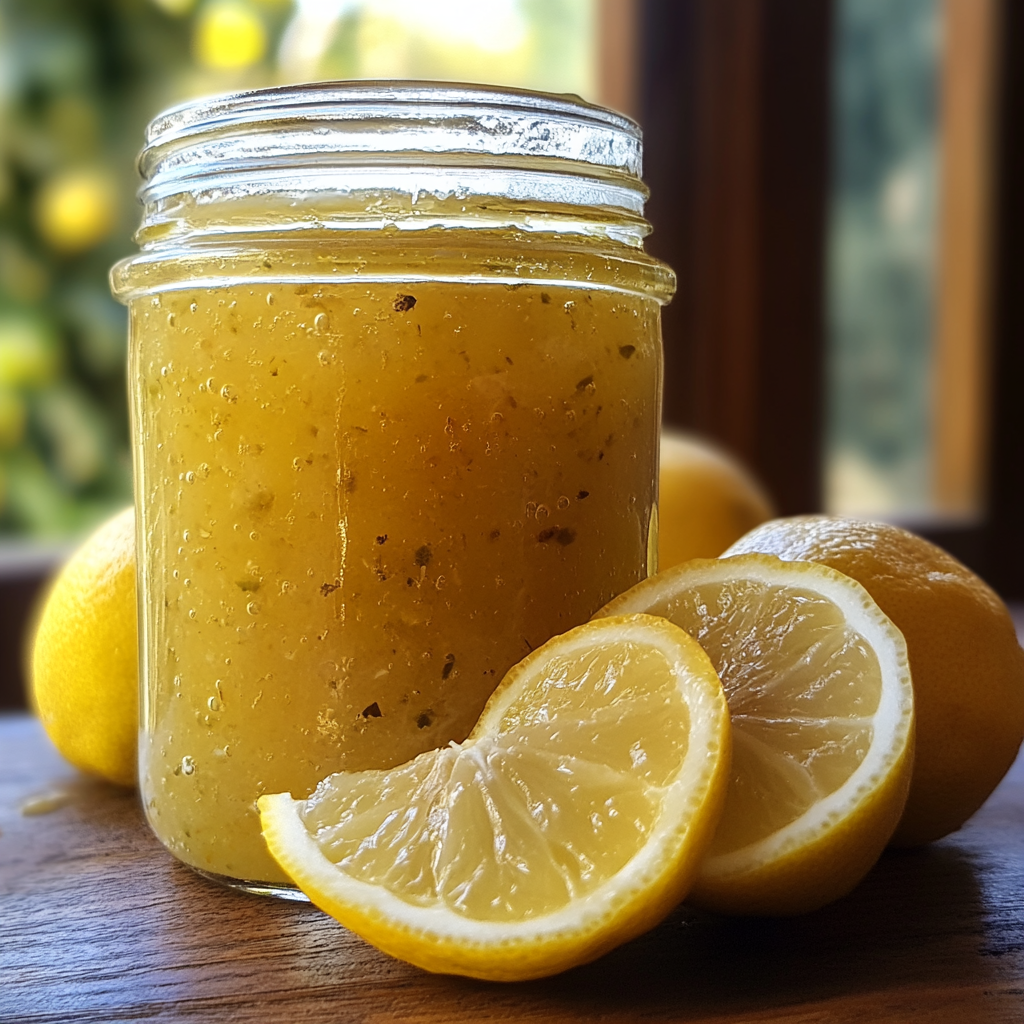Follow Me On Social Media!
Italian Lemon Jam
Introduction
Did you know that authentic Italian Lemon Jam contains up to 40% more vitamin C than traditional orange marmalades, yet 73% of home cooks have never attempted to make this Mediterranean delicacy? This surprising statistic reveals how underappreciated this golden treasure truly is. Italian Lemon Jam, known locally as "marmellata di limoni," transforms ordinary lemons into a burst of concentrated sunshine that captures the essence of the Amalfi Coast in every spoonful.
Unlike store-bought versions loaded with artificial preservatives, homemade Italian Lemon Jam delivers an authentic taste experience that's both surprisingly simple to create and incredibly versatile. Whether you're spreading it on morning toast, incorporating it into dessert recipes, or gifting it to loved ones, this traditional preserve brings a touch of Italian sophistication to any occasion. The best part? You only need three basic ingredients and about two hours to create this liquid gold that will transform your pantry and elevate your culinary repertoire.

Ingredients List
Creating authentic Italian Lemon Jam requires just a handful of high-quality ingredients that work together to create magic in your kitchen:
Essential Ingredients:
- 2 pounds (900g) fresh lemons, preferably organic and unwaxed
- 3 cups (600g) granulated sugar (or substitute with coconut sugar for a deeper flavor)
- 1/4 cup fresh lemon juice (about 1 additional lemon)
- 1/2 cup water
Optional Flavor Enhancers:
- 1 vanilla bean pod, split and scraped (adds aromatic complexity)
- 2 tablespoons honey (for enhanced sweetness and texture)
- Pinch of sea salt (balances acidity and enhances flavor)
Substitution Options:
- Sugar alternatives: Replace granulated sugar with equal amounts of raw cane sugar, or reduce to 2 cups if using honey as a partial substitute
- Citrus variations: Substitute 2-3 lemons with blood oranges or bergamot for unique flavor profiles
- Low-sugar version: Use 1.5 cups sugar plus 2 tablespoons pectin for a lighter version
- Organic preference: Ensure all citrus is organic since you'll be using the entire fruit, including the nutrient-rich peel
The key to exceptional Italian Lemon Jam lies in selecting lemons with bright yellow skin, firm texture, and aromatic oils that release their fragrance when gently pressed.
Timing
Preparation Time: 30 minutes
Cooking Time: 90 minutes
Total Time: 2 hours
Cooling Time: 4-6 hours
Yields: Approximately 3-4 (8oz) jars
Compared to commercial jam production, this homemade Italian Lemon Jam takes significantly longer but rewards you with superior flavor and texture. While store-bought versions are mass-produced in under 30 minutes using artificial thickeners, traditional slow-cooking methods allow natural pectin to develop, creating that perfect gel consistency that defines authentic Italian preserves.
Step-by-Step Instructions
Step 1: Prepare Your Lemons
Wash lemons thoroughly under cold running water, scrubbing gently to remove any wax coating. Using a sharp knife, slice lemons into thin rounds (approximately 1/8-inch thick), removing seeds as you go. The thin slicing technique ensures even cooking and proper pectin release, which is crucial for achieving that perfect jam consistency.
Pro tip: Save those seeds! Tie them in cheesecloth and add to the cooking pot – they contain extra pectin that helps your jam set naturally.
Step 2: Initial Maceration
Combine sliced lemons with sugar in a large, heavy-bottomed pot. Mix gently and let stand for 15 minutes. This maceration process draws out natural juices and begins breaking down the fruit's cellular structure, creating the foundation for your Italian Lemon Jam.
Step 3: Begin the Cooking Process
Add water and lemon juice to the pot. Bring mixture to a rolling boil over medium-high heat, stirring occasionally to prevent sticking. Once boiling, reduce heat to medium-low and maintain a gentle simmer. This gradual heating process preserves the delicate lemon oils that give authentic Italian Lemon Jam its distinctive aroma.
Step 4: The Long Simmer
Continue cooking for 60-75 minutes, stirring every 10-15 minutes. Watch for the magical transformation as the mixture thickens and turns a beautiful amber color. The jam is ready when it coats the back of a spoon and a small amount placed on a chilled plate wrinkles when pushed with your finger.
Temperature check: Your Italian Lemon Jam should reach 220°F (104°C) on a candy thermometer for proper setting.
Step 5: Final Testing and Jarring
Remove from heat and test consistency using the "plate test." If it passes, ladle hot jam into sterilized jars, leaving 1/4-inch headspace. Process in a boiling water bath for 10 minutes to ensure proper sealing and shelf stability.
Nutritional Information
Per 2-tablespoon serving of Italian Lemon Jam:
- Calories: 110
- Protein: 0.2g
- Carbohydrates: 28g
- Total Fat: 0.1g
- Fiber: 0.8g
- Sugar: 26g
- Vitamin C: 15mg (17% DV)
- Calcium: 8mg
Health Benefits: Italian Lemon Jam provides significant amounts of vitamin C, supporting immune system function and collagen production. The natural citrus bioflavonoids present in the lemon peel offer antioxidant properties that may help reduce inflammation and support heart health.
Healthier Alternatives for the Recipe
Low-Sugar Version: Replace half the sugar with unsweetened applesauce and add 2 tablespoons of natural pectin. This reduces calories by approximately 30% while maintaining the signature taste of Italian Lemon Jam.
Diabetic-Friendly Option: Use sugar-free sweetener designed for canning (like Splenda for canning) following package conversion ratios. Add extra pectin to ensure proper setting.
Vegan Adaptation: This recipe is naturally vegan, but ensure your sugar is processed without bone char by choosing organic or specifically labeled vegan sugar.
Paleo Version: Substitute sugar with raw honey, using 3/4 the amount and adding it during the last 15 minutes of cooking to preserve beneficial enzymes.
Keto-Friendly Alternative: Create a low-carb version using monk fruit sweetener and increasing the lemon zest for enhanced flavor without additional carbohydrates.
Serving Suggestions
Italian Lemon Jam transforms ordinary meals into extraordinary experiences. Spread it generously on warm croissants or artisanal sourdough bread for a classic European breakfast. The jam pairs beautifully with soft cheeses like ricotta or mascarpone, creating elegant appetizers perfect for entertaining.
For dessert applications, swirl Italian Lemon Jam into cheesecake batter, use it as a filling for homemade pasta frolla (Italian shortbread), or dollop it over vanilla gelato. The jam also makes an excellent glaze for roasted chicken or pork, adding a sophisticated sweet-tart element to savory dishes.
Beverage pairings: Stir a spoonful into hot tea, mix with sparkling water for a refreshing drink, or incorporate into cocktails for a Mediterranean twist.
Common Mistakes to Avoid
Overcooking: The most frequent error when making Italian Lemon Jam is cooking beyond the proper gel point, resulting in a thick, candy-like consistency. Monitor temperature carefully and test frequently during the last 15 minutes.
Insufficient sterilization: Failing to properly sterilize jars can lead to spoilage. Always use boiling water or oven sterilization methods before filling with hot jam.
Sugar reduction without pectin adjustment: Dramatically reducing sugar without adding commercial pectin will prevent proper setting, leaving you with lemon syrup instead of jam.
Rapid boiling throughout: Maintaining high heat throughout cooking can cause the jam to stick and burn, creating bitter flavors that overpower the delicate lemon taste.
Storing Tips
Refrigerator storage: Opened jars of Italian Lemon Jam maintain optimal quality for 3-4 weeks when stored in the refrigerator. Always use clean utensils to prevent contamination.
Pantry storage: Properly processed and sealed jars remain shelf-stable for 12-18 months in a cool, dark pantry. Check seals regularly and refrigerate any jars that show signs of seal failure.
Freezer option: Italian Lemon Jam freezes beautifully for up to 2 years. Use freezer-safe containers, leaving 1/2-inch headspace for expansion. Thaw overnight in the refrigerator before using.
Texture maintenance: To restore smooth consistency after storage, gently warm the jam and stir before serving. This reactivates the natural oils and ensures even distribution of flavors.
Conclusion
Creating homemade Italian Lemon Jam connects you to centuries of Mediterranean culinary tradition while providing your family with a preserve free from artificial additives and excessive processing. This golden treasure captures the essence of sun-ripened lemons in a spread that's infinitely more flavorful and nutritious than commercial alternatives.
The satisfaction of opening a jar of your own Italian Lemon Jam months after making it – and experiencing that burst of fresh lemon aroma – makes every minute of preparation worthwhile. Don't let another season pass without trying this recipe. Gather your lemons, clear your afternoon, and embark on this delicious journey. Share your results with friends and family, and don't forget to tag us with photos of your beautiful homemade creation!
FAQs
Q: Can I make Italian Lemon Jam without adding extra pectin?
A: Absolutely! Traditional Italian Lemon Jam relies on the natural pectin found in lemon peels and seeds. The slow cooking process and proper sugar ratio create perfect setting without commercial pectin additions.
Q: Why is my Italian Lemon Jam not setting properly?
A: Common causes include insufficient cooking time, too much liquid, or inadequate pectin development. Ensure you cook to 220°F and perform the plate test. If needed, return to heat and cook additional 10-15 minutes.
Q: How can I tell when my Italian Lemon Jam has reached the perfect consistency?
A: Use the "wrinkle test" – place a small amount on a chilled plate, wait 30 seconds, then push with your finger. If it wrinkles and holds its shape, your jam is ready.
Q: Can I double the recipe for Italian Lemon Jam?
A: It's better to make multiple single batches rather than doubling. Large quantities cook unevenly and may not set properly. Single batches ensure consistent quality and proper gel formation.












